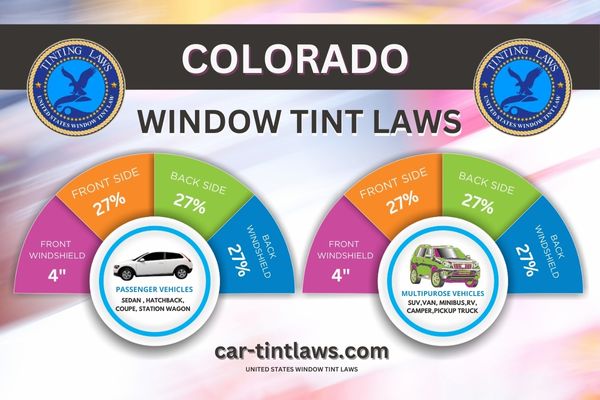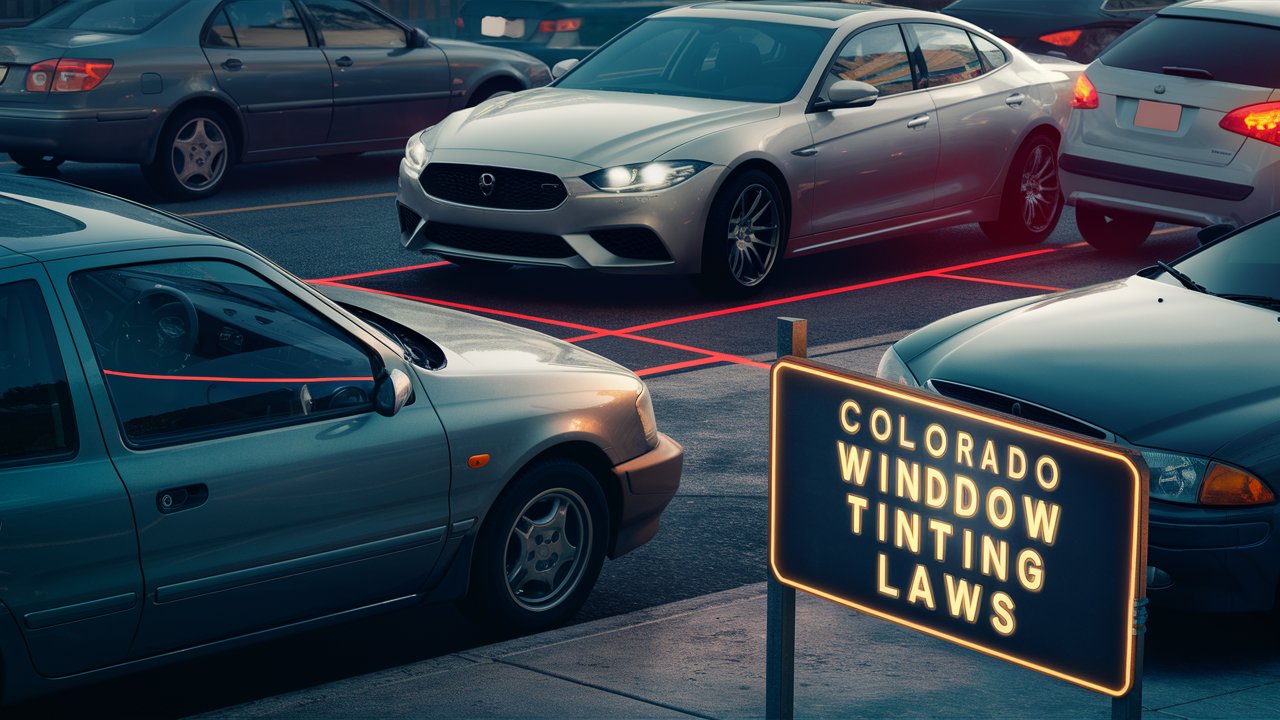You might not know that Colorado’s window tinting laws differ considerably between sedans and SUVs or vans.
For instance, while sedans can only have non-reflective tint on the top 4 inches of the windshield, SUVs and vans can extend this to 6 inches.
The rules get even more specific when it comes to light transmission requirements and the strict prohibition on reflective tints.
Given the unique climate and high elevation in Colorado, these regulations aim to balance both safety and comfort.
Curious about how this impacts your vehicle choices or medical exemptions? Let’s explore further.
Window Tint Darkness in Colorado
When considering tint darkness for sedans in Colorado, you’ll need to make sure that your front side windows allow at least 27% of light to pass through.
For SUVs and vans, the rules are more flexible, as the rear side and rear windows can have any level of darkness, provided that the front side windows still meet the 27% requirement.
Remember, the windshield can only have a non-reflective tint strip on the top 4 inches with a minimum of 70% visible light transmission.
Tint darkness for sedans:
- Windshield: Non-reflective tint is allowed on the top 4 inches of the windshield.
- Front Side windows: Must allow at least 27% of light in.
- Back Side windows: Must allow more than 27% of light in.
- Rear Window: Must allow at least 27% of light in.
Tint darkness for SUV and Vans:
- Windshield: Non-reflective 70% VLT tint is allowed on the top 4 inches of the windshield.
- Front Side windows: Must allow over 27% of light transmission.
- Back Side windows: Must allow more than 27% of light in.
- Rear window: Must allow more than 27% of light in.
Adhering to these regulations ensures visibility, safety, and compliance with Colorado’s tint darkness laws for SUVs and vans.
Window Tint Reflection in Colorado
When considering window tint reflection in Colorado, it should be emphasized that the state has specific regulations for different vehicle types.
For sedans, any reflective or mirrored tint is strictly prohibited to maintain safety and visibility.
Similarly, SUVs and vans must also adhere to these guidelines, prohibiting reflective tints to avoid glare and uphold clear sightlines for law enforcement and other drivers.
Tint reflection for sedans:
- Front Side windows: Reflective tint is not permitted on sedans in Colorado.
- Back Side windows: Reflective tint is not allowed on sedans in Colorado.
- Safety Concerns: Reflective tint can hinder visibility, especially at night or in bright sunlight, posing safety risks.
- Compliance: Following these regulations ensures clear sightlines and safer driving conditions.
- Penalties: Violations of tint reflection rules can result in fines and penalties.
- Verification: Check your vehicle’s window tinting to ensure compliance with Colorado laws.
- Safety Priority: Adhering to these guidelines enhances road safety for all drivers and passengers.
Tint reflection for SUV and vans:
- Front Side windows: Reflective tint is strictly prohibited.
- Back Side windows: Reflective tint is strictly prohibited.
Other Colorado window tint rules and regulations
- Side Mirrors: No restrictions.
- Restricted Colors: In Colorado, all tint colors are permitted.
- Certificates: Manufacturers of film need to certify the film they sell in the state. Ask your dealer if they are using certified film.
- Stickers: The sticker/label of compliance to identify legal tinting is required between the film & glass on each tinted window.
- Medical Exceptions: Colorado permits medical exemptions for special tint. For more details about the specific terms of the exemption, consult CO state law.
- Penalties: Costs associated with window tint tickets can vary, but generally include fines and potential removal fees. It’s important to stay informed about these regulations to avoid unnecessary penalties.

Medical Exemptions for Window Tint Rules in Colorado
For those with medical conditions that require additional protection from sunlight, Colorado’s window tinting laws offer a way to obtain medical exemptions for darker window tints.
These medical exemptions allow you to have a window tint darkness that is otherwise not allowed under standard regulations.
To qualify for this exemption, you need appropriate documentation from a healthcare provider.
This documentation should clearly state the medical condition that necessitates you to have increased protection from sunlight.
Once you have the appropriate documentation, you can apply for a medical exemption that permits the use of darker window tints on your vehicle.
This exemption is vital for individuals with conditions such as lupus, albinism, or other sun-sensitive ailments.
It’s important to remember that this documentation must be carried in your vehicle at all times to ensure compliance with Colorado’s window tinting laws.
Having a medical exemption not only provides you with the necessary protection but also guarantees that you are legally covered while driving with a darker tint.
Always keep your exemption documents handy, as they are essential for verifying your compliance with state regulations.
Colorado Window Tint Ticket Cost
While medical exemptions offer some flexibility, it’s essential to understand the potential costs and penalties associated with violating Colorado’s window tinting laws.
Colorado State strictly enforces window tint regulations to guarantee visibility and safety on the road.
If you’re caught with an illegal window tint, the cost of a ticket can vary significantly, from $500 to $5,000, depending on the severity of the violation and whether it’s a repeat offense.
Window tint violations aren’t just about paying fines.
They can also result in citations and, in some instances, points being added to your driving license. Law enforcement officers in Colorado may conduct window tint checks during routine traffic stops.
This means that even if you’re pulled over for a different issue, your window tint could still be scrutinized.
It’s vital to adhere to Colorado’s window tint laws, not only to avoid these steep penalties but also to maintain safe driving conditions for yourself and others.
Staying within legal limits helps guarantee everyone on the road can drive safely and without unnecessary distractions.
By following the rules, you’re contributing to a safer driving environment for all.
Colorado Geography and Demographics
When considering Colorado’s window tinting laws, understanding the state’s geography and demographics is crucial since regional climate variations, population density, and urban versus rural differences can impact how these laws are applied and enforced.
Colorado’s diverse landscape, from the cold Rocky Mountains to the milder eastern plains, influences the effectiveness and necessity of window tinting.
Additionally, the population density in urban areas like Denver compared to rural regions may lead to differing enforcement practices and considerations for vehicle owners.
Regional Climate Variations
Colorado’s diverse geography and climate variations greatly influence the state’s window tinting needs.
With mountains, plains, and desert regions, you’ll experience a range of weather conditions that affect how much light enters your vehicle.
During cold winters, especially in mountainous areas, heavy snowfall can lead to glare and visibility issues.
In contrast, hot and dry summers, particularly in the plains and desert regions, increase the need for tinted windows to manage heat and UV radiation.
Given Colorado’s high elevation, the thinner air results in increased UV radiation exposure.
This not only impacts your comfort but also the longevity of your vehicle’s interior.
Tinted windows can mitigate these effects by reducing the amount of harmful light that penetrates the vehicle, helping to keep it cooler and protecting the interior materials.
Urban areas like Denver may have different tint preferences compared to rural areas.
In cities, the demand for privacy and reduced glare during commutes might be higher.
Meanwhile, in rural and mountainous regions, outdoor enthusiasts might prioritize protection from the sun’s intense rays during activities.
Overall, understanding regional climate variations is key to making informed decisions about window tinting in Colorado.
Population Density Impact
With a population density of around 56 individuals per square mile, the enforcement and impact of window tint laws can vary greatly between Colorado’s urban and rural areas.
In densely populated cities like Denver, Colorado Springs, and Aurora, you’ll find more rigorous enforcement due to higher vehicle traffic and the need for uniform compliance.
These areas have more law enforcement resources, making it easier to monitor and guarantee adherence to window tint regulations.
On the other hand, rural areas with lower population densities experience different enforcement dynamics.
In these regions, fewer law enforcement officers are available, and the expansive geography can make consistent regulation challenging.
Residents in these areas may encounter less frequent inspections, impacting overall compliance rates.
Understanding the variations in population density across Colorado is essential to grasp how window tinting laws are implemented and followed.
Urban centers demand stricter adherence to maintain public safety and visibility for law enforcement.
Meanwhile, in less populated regions, the focus might be more lenient due to limited resources and lower traffic volumes.
By recognizing these differences, you can better navigate the complexities of window tint regulations and make sure you’re compliant with local laws, regardless of where you reside in Colorado.
Urban Vs. Rural Differences
In contrasting urban and rural areas of Colorado, you’ll notice significant differences in how window tint laws are enforced, shaped by varying geography and demographics.
In urban areas, where population density is higher, enforcement tends to be stricter.
This is because visibility and safety regulations are prioritized to manage the higher volume of traffic and diverse demographic needs.
For instance, in cities like Denver or Colorado Springs, law enforcement agencies are more vigilant about ensuring that window tinting complies with state standards to enhance road safety and reduce crime.
In rural areas, the enforcement of window tint laws can be more relaxed. These regions often have lower population densities and less traffic, which can lead to a different interpretation of the laws.
Local preferences and needs in these communities might result in more lenient enforcement practices, as the immediate safety concerns present in urban settings are less pronounced.
Additionally, the wide-open geography of rural Colorado offers more natural visibility, reducing the potential hazards associated with darker window tints.
Understanding these urban versus rural differences helps in appreciating how Colorado’s diverse landscape influences the application and enforcement of window tint laws across the state.
References
Frequently Asked Questions
What Is the Darkest Legal Tint in Colorado?
You’re wondering about the darkest legal tint in Colorado? The tint percentage limit is 27% VLT for front side windows.
While tinting regulations vary across states, window tinting offers benefits like privacy and UV protection.
Is 15% Tint Legal in Colorado?
Imagine this: you’re driving under a blanket of stars, but be careful—15% tint isn’t legal in Colorado.
For visibility and safety, you need at least 27% VLT, or face fines and consequences unless you have medical exemptions.
How Much Is a Ticket for Illegal Tint in Colorado?
If you get a ticket for illegal tint in Colorado, the cost can vary.
The fine for a noncompliant tint percentage and tint appearance ranges from $500 to $5,000, depending on the severity of the violation.
What Does 70 Tint Look Like?
A 70% tint looks almost transparent, offering high tint visibility.
Among tinting options, it’s light enough to comply with most tinting regulations, ensuring you stay within the law while reducing glare and UV exposure.
Conclusion
Understanding Colorado’s window tinting laws is essential for compliance and safety.
You need non-reflective tint on the top 4 inches of your sedan’s windshield or 6 inches for SUVs and vans.
Front side windows must allow at least 27% light transmission, while back side windows can be darker, as long as they permit 27% light.
Reflective tints are prohibited, but medical exemptions are available.
By following these guidelines, you’ll guarantee your vehicle meets state regulations.
